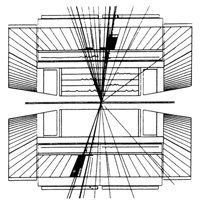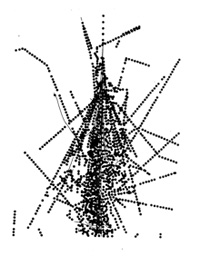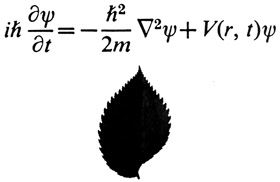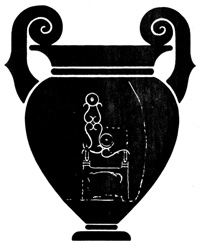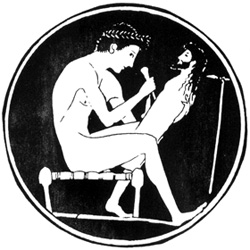"Golden Books" - The Humanness of Physics
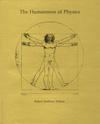 |
The Humanness of Physics Robert Rathbun Wilson |
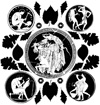 |
 |
![]()
Fermi National Accelerator Laboratory
Batavia, Illinois
Operated by Universities Research Association, Inc.
Under Contract with the United States Department of Energy
Introduction
Robert R. Wilson, Fermilab's founding director from 1967-78, defined Illinois' high-energy physics center in a style and manner quite distinctly his own. Born in Frontier, Wyoming in 1914, Wilson responded to his western training ground as a curious investigator and observer. He received his formal education in the forefront laboratories of Berkeley and Princeton, leading to his recruitment for research involvement in Los Alamos, where he served as leader of the cyclotron group and head of the experimental nuclear physics division, and also mayor of the town. Following a brief period at Harvard, Wilson went to Cornell where his mastery of experimental elementary particle physics and accelerator design was demonstrated in the successful projects of the Newman Laboratory of Nuclear Studies.
Wilson, known for his maverick approach in solving problems, also brought his specific sensitivity and aesthetic awareness, as well as visionary care for the environment, to his frontier Laboratory on the prairie. "The Humanness of Physics," written by Wilson in January, 1978, illuminates the esoteric world of this thoughtful physicist for the general reader. Creatively illustrating the philosophy he brings to physics and sharing his attitudes about the culture of humanity, Wilson inadvertently reveals his unique and remarkable qualities as a renaissance man of science. This gentle giant of modern physics is a hero to his colleagues and the model medium to elucidate the unity which binds the arts and the sciences.
The Humanness of Physics
 Does not it seem incongruous to be discussing the humanness of physics? For if one subject would appear to be lacking the quality of humanness, it is physics. Physics is characterized by precise measurement and abstruse mathematics, it is rigorous and austere; indeed it is about as objective as a discipline can get. Yet, in spite of a prevalent belief that physics is cold and inhuman, a belief that it has to do only with things, not people, a belief that its Faustian practitioners blindly follow the rites of scientific method to grind out a plethora of uninteresting facts. . . in spite of all of this, I am going to maintain that there is a quality of loveliness in the content and in the devices of physics, that it is a beautiful creation which has meaning for man's view of himself and his place in the world, and that these qualities of physics can appropriately be discussed under the rubric of humanness.
Does not it seem incongruous to be discussing the humanness of physics? For if one subject would appear to be lacking the quality of humanness, it is physics. Physics is characterized by precise measurement and abstruse mathematics, it is rigorous and austere; indeed it is about as objective as a discipline can get. Yet, in spite of a prevalent belief that physics is cold and inhuman, a belief that it has to do only with things, not people, a belief that its Faustian practitioners blindly follow the rites of scientific method to grind out a plethora of uninteresting facts. . . in spite of all of this, I am going to maintain that there is a quality of loveliness in the content and in the devices of physics, that it is a beautiful creation which has meaning for man's view of himself and his place in the world, and that these qualities of physics can appropriately be discussed under the rubric of humanness.
Philosophical Aspects
Although modern physics can be said to have begun essentially with Galileo, I prefer to see its genesis in the atomic physics of Democritus some 2500 years ago. Lucretius gives the most complete description of that ancient atomic theory in his "De Rerum Natura". This beautiful poem expresses a remarkably up-do-date version of modern ideas about atoms. The Epicureans not only had quite correct notions about atoms, but also about atoms dancing in the vacuum, or, as we say now, executing random movements. And if their ideas about force were hazy, to say the least, their idea of the random "swerve" of the atom has inherent in it rudimentary elements of quantum mechanics. The theory is simple and elegant and interesting-even correct in many respects. But Lucretius' poem is only in part devoted to a technical expression of physics. For the most part, the poem is about the problems of people caused by their superstitious beliefs. Physical occurrences at that time, no matter how trivial, were explicable almost entirely on the basis of divine intervention. Thus if the wind were to be favorable, then a god or a spirit would have to be propitiated by sacrifice. Agamemnon, setting out for Troy, must cruelly slay his fair daughter Iphigenia. Behind each rock that could stub a toe might dwell a mischievous spirit. These countless little spirits, "always about mans' path and about his bed, mostly hostile by instinct" were only to be pacified by tedious acts of worship. We are told that the lives of religious Greeks were made miserable by a multitude of gods and spirits, all bullying humans without surcease.
Atomic theory provided an alternate view of how the world worked; if one believed in the existence of atoms and in atomic theory, then that simple all-encompassing theory of everything-since everything is made of atoms-made it no longer necessary to believe in spirits as causative agents. Although Lucretius intended his eloquent poem to be a paean to Epicurean materialism, the poem comes out also as a testament to the humanity of Lucretius-it is an example par excellence of the humanness of physics.
 Yet another example is the "identity crisis" for man that was caused by Newton. His simple laws of motion seemed to explain the exact motion of all bodies in the world accurately and universally and very successfully and much more plausibly than did the vague ideas of Democritus. Because of the power and success of Newton's laws, a notion of 'cause and effect emerged in which it was reasonable to consider the universe to be just one great machine-to be like a great clock that runs all by itself-each motion being caused mechanically as an effect of the previous state of the machine. Once in motion, the positions of every part of that machine would be completely and precisely predetermined for all time. Man, also subject to Newton's law, is just a part of this machine, and hence his every movement also would be equally preordained. In such a view, man is ineluctably trapped by the physics of Newton. He is just a mechanical cog in a mechanical universe. Where is the humanness of this bleak view?
Yet another example is the "identity crisis" for man that was caused by Newton. His simple laws of motion seemed to explain the exact motion of all bodies in the world accurately and universally and very successfully and much more plausibly than did the vague ideas of Democritus. Because of the power and success of Newton's laws, a notion of 'cause and effect emerged in which it was reasonable to consider the universe to be just one great machine-to be like a great clock that runs all by itself-each motion being caused mechanically as an effect of the previous state of the machine. Once in motion, the positions of every part of that machine would be completely and precisely predetermined for all time. Man, also subject to Newton's law, is just a part of this machine, and hence his every movement also would be equally preordained. In such a view, man is ineluctably trapped by the physics of Newton. He is just a mechanical cog in a mechanical universe. Where is the humanness of this bleak view?
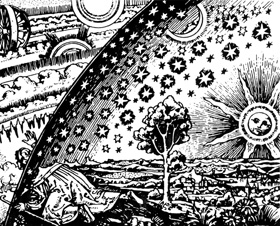 Now this was not the first discussion of the problem of free will or determinism-Greeks and scholastics had enjoyed infinite variation on this theme, but usually involving the nature of God. I think the difference is that however ridiculous or meaningless or over-simplified might be the above caricature of a world based on Newton's law of physics, to this day it still forms the basis of our modern popular materialistic philosophy. Somehow, French Encyclopedasts and other 18th century philosophers managed correctly to understand the simple physics of Newton and then to draw a plausible inference about what appeared to them to be a completely mechanical and hence materialistic and inhuman world. It seems to me that those quaintly 18th century views, based on Newtonian physics and sharpened by 19th century Darwinism, have been pretty much frozen into our literature and havebeen accepted into general thinking ever since. Perhaps much of the revulsion of some intellectuals to physics stems froman abhorrence of this miserable view of a deterministic, materialistic world. If there is any humanness in this bleak picture it is that such a superficial reading of physics should have been taken so seriously, that it should have led to such disastrous thinking, and that it should have instilled such a quality of inhumanness in so many minds. Any deeper consideration of the physics of the problem, especially from the point of view of statistical mechanics, or of how matter is actually observed, would have shown the fallacy of drawing any such conclusion about Free Will from those highly oversimplified 18th century arguments. How much better the lesson would have been had it been one of humility, of a heightened appreciation of the mystery of the universe, had it been one of pride in the human spirit to understand even then so much of that universe.
Now this was not the first discussion of the problem of free will or determinism-Greeks and scholastics had enjoyed infinite variation on this theme, but usually involving the nature of God. I think the difference is that however ridiculous or meaningless or over-simplified might be the above caricature of a world based on Newton's law of physics, to this day it still forms the basis of our modern popular materialistic philosophy. Somehow, French Encyclopedasts and other 18th century philosophers managed correctly to understand the simple physics of Newton and then to draw a plausible inference about what appeared to them to be a completely mechanical and hence materialistic and inhuman world. It seems to me that those quaintly 18th century views, based on Newtonian physics and sharpened by 19th century Darwinism, have been pretty much frozen into our literature and havebeen accepted into general thinking ever since. Perhaps much of the revulsion of some intellectuals to physics stems froman abhorrence of this miserable view of a deterministic, materialistic world. If there is any humanness in this bleak picture it is that such a superficial reading of physics should have been taken so seriously, that it should have led to such disastrous thinking, and that it should have instilled such a quality of inhumanness in so many minds. Any deeper consideration of the physics of the problem, especially from the point of view of statistical mechanics, or of how matter is actually observed, would have shown the fallacy of drawing any such conclusion about Free Will from those highly oversimplified 18th century arguments. How much better the lesson would have been had it been one of humility, of a heightened appreciation of the mystery of the universe, had it been one of pride in the human spirit to understand even then so much of that universe.
Unfortunately, physics some fifty years ago became so arcane that intellectuals in other disciplines did not notice that a revolutionary discovery in physics, quantum mechanics, made even more obvious the fallacy of drawing conclusions about Free Will based on Newton's laws. We now know that matter moves as though guided by waves. These waves only determine the probability, the chance, that a particle, or a body, will move to a certain place. Hence the motion of a body through space with a precise trajectory according to the certainty of Newton's laws has been replaced by the fuzzy propagation of a wave of chance.
What is more interesting about this from the point-of-view of humanness is that this physics-quantum physics-tells us about the limits of our ability to have knowledge about some conditions of our universe, that there are some questions which we can ask that have no meaning. The theory specifies in a quantitative way just what is certain and what is uncertain. I submit that this precise and surprising information about the limits of man's knowledge is apropos to a quality of humanness. It informs us about ourselves and it leads to a greater appreciation of the mysterious nature of our world.
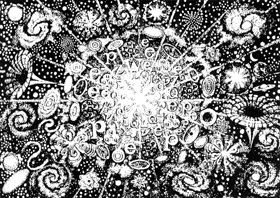 In the same way, the theory of relativity teaches us about other bizarre but very real phenomena of this world. For example, it is really true that two people can age at a different rate if one person is in motion with respect to the other. Pirandello could have made an even more dramatic study of the nature of reality-a quality of humanness-had he more thoroughly studied the theory of relativity (if he studied it at all!)
In the same way, the theory of relativity teaches us about other bizarre but very real phenomena of this world. For example, it is really true that two people can age at a different rate if one person is in motion with respect to the other. Pirandello could have made an even more dramatic study of the nature of reality-a quality of humanness-had he more thoroughly studied the theory of relativity (if he studied it at all!)
Let me turn to a somewhat different aspect of the humanness of physics in man's knowledge of man. Since time began, one could question as did Matthew Arnold about
"The hills where his life rose
and the sea where it goes"
Originally these questions of from whence do we come and whither are we going were considered to be strictly the province of religion and of myth. What I find utterly astounding now is how modern cosmogony and cosmology-which, as a physicist, I arrogantly relegate to physics - can inform us about how our world came into being. On the basis of nuclear physics and of various observations, we know that the world began, not with a whimper, but with a bang! Nuclear physics and relativity tell us in amazing detail how, from that mighty big explosion about ten billion years ago, energy expanded outward, how the firmament separated from the chaos, how matter in all its forms was produced in known nuclear reactions, and how that matter condensed to form stars and planets. Nuclear physics makes possible the knowledge of the life cycle of stars, about what keeps them hot; how some collapse, and some explode-and how some become deep black holes in space.
This partly written "book of Genesis" still does not "explain" the "why" of the big bang. However, if we assume in a biblical sense that in 'the beginning was not the "word", but that instead there was just a tremendous explosion of pure energy from a point in space, a bang, then from that event our detailed knowledge of nuclear physics has made it possible to give a fuller explanation of "from whence we came" than had ever been given before. The account not only reads like the book of Genesis, it reads like a fascinating detective story. From a very few clues, a more complete "De Rerum Natura" has been deduced. It is a towering intellectual accomplishment, comparable to or even exceeding 18th century poetry or even Renaissance painting. It has added to the measure of man-to his humanness. His spirit, his human spirit, that is, soars out over time and space-and the vehicle of that spirit is nuclear physics!
Aesthetic Aspects
 Now let me turn to aesthetic aspects of physics. We physicists are proud of the monumental laws of nature we have been able to formulate. For a physicist, the laws of physics themselves have great beauty. The laws express so much in such elegant form, that we can compare them to poetry, and in particular, because of their brevity, compare them to the Japanese seventeen syllable haiku. Unfortunately, just as the haiku is not accessible to most of us because we do not know Japanese, in the same sense, the poems of physics are also not accessible to most of us because we do not understand the language of mathematics.
Now let me turn to aesthetic aspects of physics. We physicists are proud of the monumental laws of nature we have been able to formulate. For a physicist, the laws of physics themselves have great beauty. The laws express so much in such elegant form, that we can compare them to poetry, and in particular, because of their brevity, compare them to the Japanese seventeen syllable haiku. Unfortunately, just as the haiku is not accessible to most of us because we do not know Japanese, in the same sense, the poems of physics are also not accessible to most of us because we do not understand the language of mathematics.
It is no accident that the laws of physics are beautiful. In groping toward many of the great truths of physics, intuition is an important guide, and beauty is one of the beacons which guide that intuition.
Keats tells us:
"Beauty is truth, truth beauty,-that is all
Ye know on earth, and all ye need to know"
but we physicists find it helpful, in arriving at a truth, also to depend upon a few experimental observations. Einstein, however, used a minimum of experimental information in formulating his theory of relativity. He wrote that an aesthetic feeling of "rightness" and a sense of beauty were dominant factors in his thinking. Even when the first experiments of Kaufmann seemed to be in contradiction with his theory, Einstein persisted in belief in his structure. Why? Because he felt it was beautiful!
Dirac, the theoretical physicist whose theories first led to the concept of antiparticles, has explained how he gave overriding priority to aesthetics in formulating his theory. He also has pointed out how Schroedinger, one of the founding fathers of Wave Mechanics, put forward the "Schroedinger Equation", basic to Wave Mechanics, in spite of apparent contradicting experimental evidence-again because he thought his equation was beautiful. My point here is that aesthetics is an important part of physics.
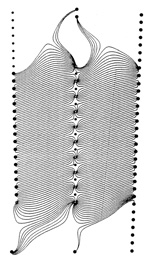 For example, we physicists like to look for something that is symmetrical in the world. Many of our deepest truths about nature are expressed by a symmetry that we are able to recognize in a property of nature. Thus we like to see that our laws of motion are exactly the same when viewed through a looking glass, that is, when we have interchanged everything on the right side to the left side. That shows a symmetry in space. We might also look for a symmetry in time, by expecting our laws to work as well when time is reversed; for example, Newton's laws are the same for the objects in a movie even when the projector runs backward. Still, symmetry can be boring, so after we have recognized a property of nature that is symmetrical, we are utterly delighted to find any small deviation from the rule.
For example, we physicists like to look for something that is symmetrical in the world. Many of our deepest truths about nature are expressed by a symmetry that we are able to recognize in a property of nature. Thus we like to see that our laws of motion are exactly the same when viewed through a looking glass, that is, when we have interchanged everything on the right side to the left side. That shows a symmetry in space. We might also look for a symmetry in time, by expecting our laws to work as well when time is reversed; for example, Newton's laws are the same for the objects in a movie even when the projector runs backward. Still, symmetry can be boring, so after we have recognized a property of nature that is symmetrical, we are utterly delighted to find any small deviation from the rule.
Tsung Dao Lee, who, with Frank Yang, first conceived the idea that the mirror symmetry was occasionally broken, has emphasized the similarity of the slightly broken symmetry with classical sculpture. He cites many examples of statues that are almost symmetrical-but are only lovely because of small departures from exact symmetry. Similarly, this is true of poetry. A too symmetrical poem becomes doggerel; it is subtleness and surprise that characterizes great art and great physics as well. Physicists not only use aesthetics to guide them, they also use the language of aesthetics to discuss their subject. Is not all this use of the language of aesthetics just another way of acknowledging a quality of humanness in physics?
In experimental physics, too, aesthetics plays a role. For example, the artifacts of physics themselves usually have an innately handsome quality that is quite independent of their function even though the quality of beauty derives from the function. Thus antique balances, or electroscopes, or magnetometers have now become valuable objects that are collected and exhibited in the salons of the wealthy. Those objects were designed by scientists who cared about appearance as well as function-or better, who appreciated the relationship between form and function and appearance. Most instruments or machines of physics are designed as a picture is painted; the parts are one with the whole, the whole is one with the parts-all directed toward and expressing the function.
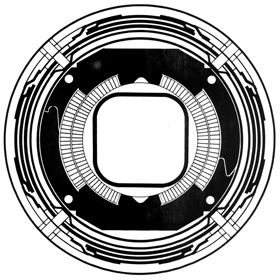 I, as an accelerator builder, have found great satisfaction in relating to the men who built cathedrals in the thirteenth century. When Ernest Lawrence built his cyclotrons with a dedicated passion he was not that different from Suger, also with a dedicated passion, building the cathedral St. Denis. The Abbot Suger was expressing a devotion to the church with his exalted structure, a structure that transcended all contemporary knowledge of strength of materials. And Lawrence, too, expressed, in his fashion, a devotion to the discovery of truth. He, too, transcended contemporary technology in attaining his dizzying heights of energy. I am sure that both the designers of the cathedrals and the designers of the nuclear accelerators proceeded almost entirely on educated intuition guided largely by aesthetic considerations. This can be seen explicitly in the notebooks of Villard d'Honnecourt, one of the ancient architects; his designs of parts of cathedrals are sometimes mixed up with drawings of the human form.
I, as an accelerator builder, have found great satisfaction in relating to the men who built cathedrals in the thirteenth century. When Ernest Lawrence built his cyclotrons with a dedicated passion he was not that different from Suger, also with a dedicated passion, building the cathedral St. Denis. The Abbot Suger was expressing a devotion to the church with his exalted structure, a structure that transcended all contemporary knowledge of strength of materials. And Lawrence, too, expressed, in his fashion, a devotion to the discovery of truth. He, too, transcended contemporary technology in attaining his dizzying heights of energy. I am sure that both the designers of the cathedrals and the designers of the nuclear accelerators proceeded almost entirely on educated intuition guided largely by aesthetic considerations. This can be seen explicitly in the notebooks of Villard d'Honnecourt, one of the ancient architects; his designs of parts of cathedrals are sometimes mixed up with drawings of the human form.
 My own experience has been in designing modern accelerators. These are exceedingly complex machines which are characterized by large mechanical and electrical systems and by complicated forms which are pierced by vacuum pipes, which are immersed in magnetic fields, and in which atoms are joggled by electric fields, and jiggled by electronic devices. Informing and controlling this complex is a nervous system that consists of a ganglia of microprocessors and a gaggle of computers. Now to understand each complicated component and its relationship to the whole would go well beyond my own technical knowledge. So how do I go about designing? Well, I find out a little here, by a simple calculation, and a little there, by a string of such calculations, about parts of the most important technical components. I then sketch those parts of the design on paper. After that, I just freely and intuitively draw in neatly appearing smooth lines, lines which cover my ignorance of detail. I keep drawing, correcting here and there by calculations until the accelerator takes form and appears that it might work. Mostly I know it might work because it looks and feels right-not because of any long and detailed chain of calculations, which after all might take forever. It is when the parts and forms have essentially the same relationship that the parts of a sculpture should have to the whole that I am satisfied by the design. Of course, building, even designing, a large accelerator is a complex team activity - just as it was for the cathedral. But if the conceptual design is aesthetically right, then one can depend on the members of a team to appreciate and to understand and to respect that aesthetic form in their own creative contributions. An accelerator that is "understood" works. What I am trying to express by a certain amount of exaggeration is that most of the effort of design is intuitive, that aesthetics are indeed a valuable and necessary guide in any design process, that these very human qualities are an important part of physics and give to physics a quality of humanness.
My own experience has been in designing modern accelerators. These are exceedingly complex machines which are characterized by large mechanical and electrical systems and by complicated forms which are pierced by vacuum pipes, which are immersed in magnetic fields, and in which atoms are joggled by electric fields, and jiggled by electronic devices. Informing and controlling this complex is a nervous system that consists of a ganglia of microprocessors and a gaggle of computers. Now to understand each complicated component and its relationship to the whole would go well beyond my own technical knowledge. So how do I go about designing? Well, I find out a little here, by a simple calculation, and a little there, by a string of such calculations, about parts of the most important technical components. I then sketch those parts of the design on paper. After that, I just freely and intuitively draw in neatly appearing smooth lines, lines which cover my ignorance of detail. I keep drawing, correcting here and there by calculations until the accelerator takes form and appears that it might work. Mostly I know it might work because it looks and feels right-not because of any long and detailed chain of calculations, which after all might take forever. It is when the parts and forms have essentially the same relationship that the parts of a sculpture should have to the whole that I am satisfied by the design. Of course, building, even designing, a large accelerator is a complex team activity - just as it was for the cathedral. But if the conceptual design is aesthetically right, then one can depend on the members of a team to appreciate and to understand and to respect that aesthetic form in their own creative contributions. An accelerator that is "understood" works. What I am trying to express by a certain amount of exaggeration is that most of the effort of design is intuitive, that aesthetics are indeed a valuable and necessary guide in any design process, that these very human qualities are an important part of physics and give to physics a quality of humanness.
Creative Aspects
Physics is not developed by mechanically following an arbitrary set of rules that lead automatically to new knowledge. For example, just blindly following the so-called scientific method will get you nowhere! Now, the physics that ultimately appears in textbooks is usually expressed in an elegant, but nearly incomprehensible, mathematical form. It is very different, however, during the process of discovery, when one is groping toward a truth and when the knowledge is necessarily elemental and very simple. Not too much is known about how the mind of a physicist comes to produce new physics, just as not much is known about how the mind of the artist comes to produce new works of art. One thing is clear, it is that there is much in common between what the creative artist does and what the scientist does. Scientists and artists even use similar words in describing their creative moments. They both care deeply about what it is they do and they tend to be single-minded in going about doing it. They both usually pass through a morose period when their contemplation is deep, and mostly at a subconscious level. Finally, what they do create just comes bubbling up from the subconscious to the conscious mind. Inevitably this inspirational act is accompanied by a period of euphoria, an ecstasy which has been documented time and again for scientist and artist alike.
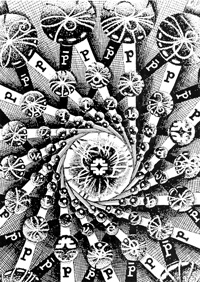 Those qualities that we identify with humanness are as active and important in physical research as they are in painting or poetry. The artist and the scientist appear to take on very similar roles at the level of creating knowledge. Even their personalities are similar-they tend toward the idiosyncratic. Take Einstein and Picasso, both dressed in sweat shirts, neither wore socks, and they were very strong, individualistic characters.
Those qualities that we identify with humanness are as active and important in physical research as they are in painting or poetry. The artist and the scientist appear to take on very similar roles at the level of creating knowledge. Even their personalities are similar-they tend toward the idiosyncratic. Take Einstein and Picasso, both dressed in sweat shirts, neither wore socks, and they were very strong, individualistic characters.
If the act of creativity in science and art is similar, is there not a similarity, as creations, in the content of art and of science? Are not both equally creations of the human mind? This is not to deny, in any way, the independent existence of that mysterious but objective reality "out there". However, there are many ways that we could come to perceive that reality, and the particular way that it has evolved and the particular corner of reality that has been explored might both be considered to be arbitrary creations of the mind of man, just as are the artistic creations.
The fundamental concepts themselves, such as distance, or mass or time, are idealizations of nature and they had to be invented by man. Perhaps it might be more accurate to say, that such concepts had to evolve with our language, but after all, language itself is a human creation. For example, the concept of time which has evolved for peoples with different languages appears to be quite different; we all experience the remarkable difference between the passing of psychological time and of clock time. The art of science has been to create concepts, and then to create theories using those concepts that correspond to reality.
If it is at all plausible that the concepts of physics themselves have at least in some degree been arbitrary creations of man, rather than being "revealed truth", or being something that was just inherently obvious to anyone, then it might also be plausible to go on and to inquire if all knowledge of physics has not in large measure been created by the mind of man-just as Dante created his many-leveled universe of Paradise and Inferno. The difference is that physics must constantly, step-by-step, be consistent with the world of reality as determined by experiment. And of course the objects of our reality have a continuing reality which is largely independent of how we perceive them.
What I am saying here is in a sense perhaps just an exaggerated form of the "three Worlds" of Karl Popper. His first World has to do with things. His second World is that of subjective experience of thinking. His third World consists of statements and theories and of mental constructs, physics if you will, and is one which I am sure he would agree is a creation (in an evolutionary sense) of the mind of man.
But how can I maintain my belief in an objective reality and at the same time suggest that the world we know is even some part a creation of man? To try to clarify that dichotomy, let me compare the physicist creating knowledge to an artist creating a painting. The artist starts with a blank canvas, some paints, and the tools for applying them. He makes a few initial strokes that pretty much determine the final nature of the picture. These initial strokes might be analogous to the fundamental concepts with which the physicist starts. The ultimate picture may correspond to one of our theories. The artist can start again with exactly the same amount and kind of paint, and then use it all up to complete a new picture. From a chemical and a physical point of view, the two pictures he has produced might be judged to be very nearly identical but the meaning of the paintings to someone observing them can be utterly different. Indeed, any number of such "identical" pictures could be made starting with exactly the same ingredients but all could turn out to have utterly different meanings and all be original creations.
The canvas and the paint, which would be physically and chemically the same for all the paintings in this example, and which are quite independent of the painter, correspond in my analogy to physical reality. Without violating that reality, the painting is made and it will come out differently each time each is a creation, even though the painter does not create the paint or the canvas. So might it be for the physicist. His reality is more mysterious, and more circumscribed, but it is plausible that were man to start again from the beginning, then the science which would evolve and hence the world he would perceive might appear different to him than it does to us. In that sense the world we perceive is a creation of man; in that sense, it is a manifestation of the humanness of physics, and in that sense, we do not have new worlds to conquer, or even new worlds to discover. We have new worlds to create.
If man does create in some sense his world, then he has a responsibility for that world-a responsibility for the success or failure of that world. One of the greatest failures is the inhumanness of the world of physics. Physicists, not unnaturally, have taken the business of physicists to be the creation of physics. The business of physicists should also be concerned with the poetry and drama of physics, with the beauty of its form and function. The business of physics should also be the business of humanists and artists. Where have we lost the direction of Lucretius?
I take the optimistic view of man. He will survive the inhumanities of his technological culture, and I believe that his culture will evolve to a new and richer level-that he will create a new world. But I agree with T. N. Whitehead that "unless we can make man, his culture and his ideals, of central importance to the physical scientist in his own work, we are in serious danger of sinking to the level of technologically skillful barbarians". Perhaps in the humanness of science and art, the humanists, the artists, and the scientists can find a unity in their cultures.
Thanks
Sue Grommes ● Adrienne Kolb ● Rocky Kolb ● Bruce Chrisman
John Peoples ● Robert R. Wilson ● Leon M. Lederman
S. Chandrasekhar ● Leonard Euler's Illustrator ● Angela Gonzales
Pablo Picasso ● East Indian Mythology ● 5th Century B.C. Athenian Vase
5th Century B.C. Greek Mythology ● Leonardo da Vinci
Painters and Potters ● Hans Bethe ● Fermilab Photography ● Al Johnson
John Keats ● Emily Dickinson ● Jean Lemke ● Marcel Proust
Chocolate ● Lillian Hoddeson ● William Shakespeare
19th Century Illustration Depicting a Mechanical Universe
5th Century B.C. Greek Mythology ● Leonardo da Vinci
This publication was selected from the treasures of the Fermilab Archives.




